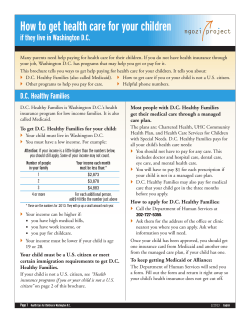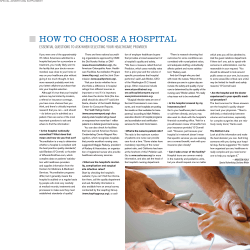
Attention: Health care Professional ...
Sector-Wide Health Solutions “ A Step forward in Health Care” Sector-Wide Health Solutions “ A Step forward forward in Healthcare Attention: Health care Professional Spring2013 Electronic Health Record Fact Sheet Medicaid/Medicare meaningful use Government incentive **The American Recovery and Reinvestment Act (Recovery Act) of 2009 provides incentive payments for Medicaid and Medicare eligible professionals (EPs) who adopt, implement, or upgrade meaningfully use certified electronic health record (EHR) technology in their first year of participation in the program and successfully demonstrate meaningful use in subsequent years. Section 1903(t)(3)(B) of the Recovery Act defines the term eligible professional to mean the following five types of Medicaid/Medicare professionals: Physicians, dentists, certified nurse-midwives, nurse practitioners, and physician assistants. Hospital-based EPs are generally not eligible to participate in the EHR incentive program. The only exception is that Medicaid/Medicare EPs practicing predominately in an FQHC or RHC are not subject to the hospital-based exclusion. The Health Information Technology for Economic and Clinical Health (HITECH) Act provides the Department of Health & Human Services (HHS) with the authority to establish programs to improve health care quality, safety, and efficiency through the promotion of health IT, including electronic health records and private and secure electronic health information exchange. Under HITECH, eligible health care professionals and hospitals can qualify for Medicare and Medicaid incentive payments when they adopt certified EHR technology and use it to achieve specified objectives. What is an EMR/EHR? An Electronic Medical Record (EMR) contains detailed information of the care provided at every encounter of the provider. It is the digital version of paper-based medical record. The purpose of the patient medical record is three-fold: to manage patient care, to create a legal record of that care, and to drive billing. While paper charts are still the backbone of many medical facilities, they are being replaced by electronic medical records (EMR) to facilitate ease of communication, coordination of care and effectiveness of treatment. An EMR is a structured and integrated method of gathering, storing and retrieving, and sharing of a particular patient’s healthcare record. The Electronic Medical Record (EMR) is an evolving concept, starting from storing medical records on computers - moving to computerized patient records, and recently being developed as an Electronic Health Records (EHR) system. Effective implementation of EMR helps in reducing administrative overheads that may add up to the bottom line profits for healthcare providers. In addition to this, it may result in increased revenue through effective utilization of resources, resulting in greater number of patients being attended to. 1 Sector-Wide Health Solutions “ A Step forward in Health Care” Sector-Wide Health Solutions “ A Step forward forward in Healthcare Benefits to an EMR: EMR helps to improve clinical efficiency in the following ways: Providing improved accessibility to patient records Improved communication between provider and clinical departments such as pharmacy, laboratory, and radiology departments Improved communication among healthcare facilities Reduced transcription cost and lesser number of chart pulls Improved clinical decision making EMR solutions help to achieve paperless administration across the healthcare industry. This form of administration facilitates creation of a centralized patient repository. The records generated through successful implementation of EMRs in healthcare practices can be used for various purposes such as patient care, administration, research, healthcare quality improvement, and processing of reimbursements. EMR is a part of healthcare information technology that is used to make paperless computerized patient data in order to increase efficiency of hospital systems and reduce chances of errors in medical records. Doctors and other eligible professionals can qualify for incentive payments totaling as much as $44,000 through Medicare or $63,750 through Medicaid. Hospitals can qualify for incentive payments totaling some $2 million or more. For the purposes of the Medicare and Medicaid Incentive Programs, eligible professionals, eligible hospitals and critical access hospitals (CAHs) must use certified EHR technology. Certified EHR technology gives assurance to purchasers and other users that an EHR system or module offers the necessary technological capability, functionality, and security to help them meet the meaningful use criteria. Certification also helps providers and patients be confident that the electronic health IT products and systems they use are secure, can maintain data confidentially, and can work with other systems to share information. The following practitioner types are eligible to receive incentive payments: 2 Physicians (doctors of medicine and osteopathy) Dentists Certified Nurse-Midwives Physician Assistants practicing in a Federally Qualified Health Center (FQHC) or Rural Health Clinic (RHC) that is led by a Physician Assistant Nurse Practitioners Sector-Wide Health Solutions “ A Step forward in Health Care” Sector-Wide Health Solutions “ A Step forward forward in Healthcare Incentive payments to eligible professionals (EPs) are disbursed over the course of six program participation years, according to the following schedule: Participation Year Incentive Payment Amount Year 1 $21,250 Year 2 $8,500 Year 3 $8,500 Year 4 $8,500 Year 5 $8,500 Year 6 $8,500 Total $63,750 Note that participation years do not necessarily need to be sequential - participants may skip years without penalty, although the last year to receive incentive payments is 2021. The last year that a provider may begin receiving payments is 2016. In order to be eligible for incentive payments, practitioners must not be hospital-based (meaning they must furnish more than 10% of their covered services outside the inpatient and emergency department settings) and they must demonstrate a minimum Medicaid patient volume as follows: Most practitioners will need to demonstrate that at least 30% of their patient encounters were paid all or in part by Medicaid. Pediatricians who do not meet the 30% Medicaid patient volume threshold may qualify if they demonstrate at least 20% Medicaid patient volume, although in this case the incentive amount is reduced by 1/3. Providers who practice predominately in an FQHC or RHC may qualify if they demonstrate that at least 30% of their patient encounters were for "needy" patients, which includes Medicaid, Child Health Plus, uncompensated care, and services billed on a sliding scale based on the patient's ability to pay. In order to receive an incentive payment in the first year of participation, an EP must demonstrate that he or she has adopted, implemented, or upgraded certified EHR technology. In subsequent years of participation, EPs must demonstrate that they are meaningfully using the certified EHR technology by satisfying a set of objectives. Let us help you get the first year’s incentive payment of $21, 250, within 90 days. No money up front, no risk guarantee!! 3 Sector-Wide Health Solutions “ A Step forward in Health Care” Sector-Wide Health Solutions “ A Step forward forward in Healthcare Snapshot of Improved Health Care Quality and Convenience for Providers Quick access to patient records from inpatient and remote locations for more coordinated, efficient care Enhanced decision support, clinical alerts, reminders, and medical information Performance-improving tools, real-time quality reporting Legible, complete documentation that facilitates accurate coding and billing Interfaces with labs, registries, and other EHRs Safer, more reliable prescribing Snapshot of Improved Health Care Quality and Convenience for Patients Reduced need to fill out the same forms at each office visit Reliable point-of-care information and reminders notifying providers of important health interventions Convenience of e-prescriptions electronically sent to pharmacy Patient portals with online interaction for providers Electronic referrals allowing easier access to follow-up care with specialists EHRs Improve Information Availability With EHRs, patients' health information is available in one place, when and where it is needed. Providers have access to the information they need, at the time they need it to make a decision. EHRs Can Be the Foundation for Quality Improvements Reliable access to complete patient health information is essential for safe and effective care. EHRs place accurate and complete information about patients' health and medical history at providers' fingertips. With EHRs, providers can give the best possible care, at the point of care. This can lead to a better patient experience and, most importantly, better patient outcomes. Practices also report that they utilize extracted reports on patient and disease registries to track patient care as well as facilitate quality improvement discussions during clinical meetings.1 EHRs Support Provider Decision Making EHRs can help providers make efficient, effective decisions about patient care, through: 4 Improved aggregation, analysis, and communication of patient information Clinical alerts and reminders Support for diagnostic and therapeutic decisions Built-in safeguards against potential adverse events Sector-Wide Health Solutions “ A Step forward in Health Care” Sector-Wide Health Solutions “ A Step forward forward in Healthcare Benefits of Electronic Medical Records to Medical Practice Operations By storing health information electronically through electronic medical record systems, health care providers are able to finish their patient charting quicker, allowing for the scheduling of more patients. This heightened efficiency of this type of medical records storage fosters a more effective medical practice. Having instant access to electronic health records allows providers to chart during their patient encounters as opposed to several hours later. In theory, this enhances accuracy of the patient’s health record. Proponents of EMR/EHRs also argue that digital medical record storage helps prevent filing errors. Most paper patient records are not backed up in a secondary location. Medical records storage through digital means eliminates any threats of losing the patient health information in an emergency. Many electronic medical record systems are backed up every day automatically and are accessible almost anywhere in the world. Cost Benefits of EMR / EHR Besides improving care for patients, another advantage of EMR integration is that it can reduce costs for physicians. Unnecessary staff expenses and storage costs are eliminated with electronic medical records storage because they take up less space and are more easily accessible than paper versions. Additionally, the cost of medical record chart materials are replaced by inexpensive maintenance costs, which helps pay for the investment over time. This EMR software revolution could bring an end to millions of manila folders holding countless pieces of patient information and scribbled notes. In their place, proponents hope, are EMR software systems that can transport patient information in real time with the click of a button. Electronic medical records software seeks to create a more efficient, accurate and productive healthcare business, all at a lower cost. EMR revenue related increases may also be a benefit of less paper work. EMR Benefits One of the EMR benefits is that the records contain a patient’s full medical history in a digital format, allowing immediate access to secure patient data. With an electronic medical record system, patients’ health and medication history, laboratory results and more are easily accessible by physicians and healthcare providers. The reduced costs that are associated with an EMR system have the potential to save the healthcare delivery system millions of dollars. Medical electronic records minimize waste and inefficiency of manual and paper-based processes, maximizing clinical quality at points of decision-making and eliminating most paper used in patient transcription. Plus, a million fewer sheets of paper copied each month support a much greener industry. 5 Sector-Wide Health Solutions “ A Step forward in Health Care” Sector-Wide Health Solutions “ A Step forward forward in Healthcare Electronic Health Records Software Saves Time Another one of the EMR benefits is that this type of software can help save time. At MemorialCare health system in California, which has adopted electronic medical records at all of its hospitals, less than 4 percent of physician orders are written, thus eliminating almost all transcription errors. As a result, satisfaction has increased as physicians are able to more easily retrieve complete patient medical electronic records information. Also, turnaround times for initial physician orders of ‘stat’ medications are on average reduced from 41 to 6 minutes. Fewer phone calls to clarify physician orders and the increased efficiency of electronic health records software means more time for clinicians to help patients. Further EMR benefits include the prevention of unnecessary orders and diagnostic tests, reduction of medical errors and improvement in patient care. 6
© Copyright 2025





















